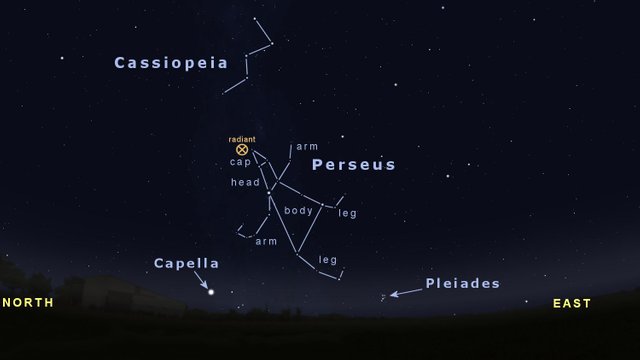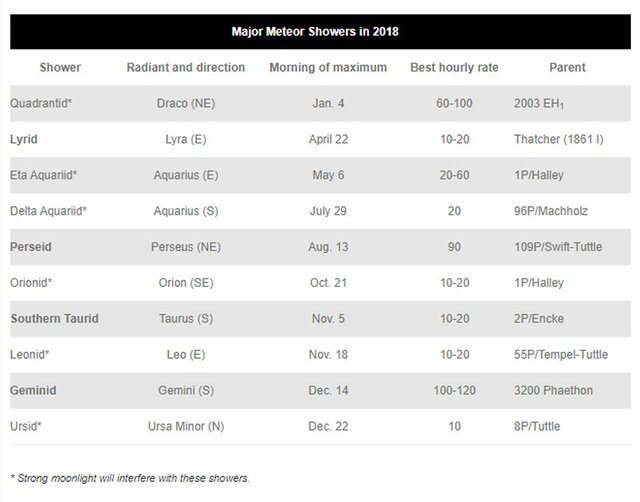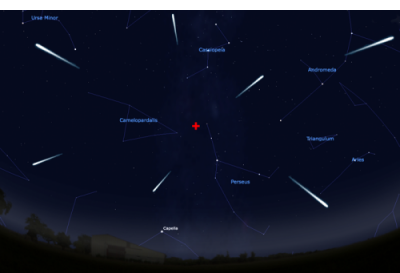Perseid Meteor Shower
During the course of Earth's yearly trip around the Sun, we pass through the debris fields left behind by several different comets, and each of these produce an increased number of meteors, called a "meteor shower."
All meteors originate from within our solar system, that grouping of things that is immediately orbiting our own star which we call the Sun. All other stars in the sky are a very far distance away from us, measured in trillions of miles and more. However, from our vantage point it appears that the meteors are coming from a point among those far-away stars even if they aren't. It's like seeing your child across the yard, running towards you, while a distant mountain is in the background; the child isn't coming from the mountain, just the other side of the yard, but the mountain is there in the background, nonetheless.

• SCREENSHOT FROM STELLARIUM, ENHANCED BY ME •
The best meteor shower each year is one that appears to be coming from the direction of the constellation Perseus (pronounced like the English words: pear - see - us), so the meteor shower is named the Perseids (like: pear - see - ids). That grouping of stars was fancied as the hero Perseus from Classical Greek literature. The Perseids are caused by debris left from the passage of Comet Swift–Tuttle (named for the two gentlemen who discovered it), which orbits the Sun once every 133 years. The Earth passes through the path of this comet every year in mid-August, with the 12th and 13th bringing the most visible meteors. For a week or two on each side of this date, though, Perseids might be seen, but there will be more around the peak dates.
The constellation of Perseus is not particularly easy to see unless one is in a location with very dark skies. However, another constellation, Cassiopeia (pronounced: cass - ee - oh - PEE' - ah) is just above Perseus and much easier to find! Just look for a grouping of stars shaped like the letter "W." In Greek mythology, Cassiopeia was a queen who wed her daughter, Andromeda, to Perseus after he saved the kingdom from a sea monster.
Meteors can appear anywhere across the sky. If one draws an imaginary line backwards, however, the Perseids will all appear to be originating from a spot near the cap of the hero. This apparent point-of-origin is called a radiant. If the imaginary line drawn backwards does not line-up with the radiant, then you have spotted a random meteor that is not part of the regular Perseid stream.
The best time to watch for meteors is always after the midnight-1am timeframe. The reason for this is because between then and dawn, the Earth is positioned so that it is pointing into the stream, instead of away from it. To visualize why, imagine being in the back seat of a car driving down a road — if you look out one window, you will see the pretty countryside, but miss any cars that are passing you; but, looking out the other window, you will see all those cars!
To spot the most meteors, use a chair that reclines backwards, or lie on a blanket, where you have as unobstructed view of the sky as possible. Just be sure to use mosquito repellant!

~ Happy Meteor Watching! ~
 😊
😊SOURCES
1 Wikipedia: Perseids
2 Wikipedia: Perseus
3 Wikipedia: Pleiades
4 Wikipedia: Subaru


source:Sky&Telescope.com

Full Moon & Mars in Conjunction • Exoskeleton
Fun Under the Night Sky • Venus, Evening Star • Fire Hydrants
Round Bottom Bottles • Micrometers and Precision Measuring
Climbing a Mountain with Trigonometry • I Wish You Cheer
Dynamics of Autumn • How Rocks Get Their Color

a big hug is due to @enginewitty for designing the following personal banner for me 🤗






cool post! we were all talking about this the other night in one of my groups as it was going on. :) hilarious you put up the suburu logo. are you from P mah kittygirl? 😁😛😁🌷
very informative you share knowledge about the solar system and I am very fond,
Thanks for these explanations! You really did a great job there and I didn't know most of the details.
We watched the Meteor shower on the two last nights (always lying outside till 3am) and we really saw lots of shooting stars, some of them amazingly big. 😃
These are always lovely to see, thank you for so much information about them.
I love things like this! I always seem to miss the memos on when the meteor showers are visible in my area - hoping to catch the next one which I think is in December!
And since the best time to view them is after midnight... as why I have never seen them, lol
So awesomely informative and educational — as per usual. ⭐️ I’ll be gazing through my skylights tonight and tomorrow, hoping to catch a glimpse of these Perseus/Perseids twinklers. 🤗💜
All these views of the night sky make me sad..I live in Dublin..clouds...clouds everywhere
Thanks for sharing your knowledge! I actually saw quite a few "shooting stars" this weekend :)